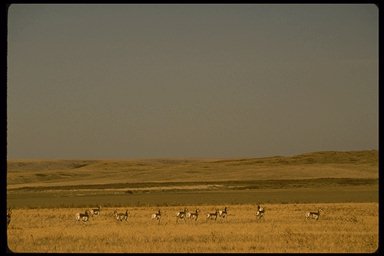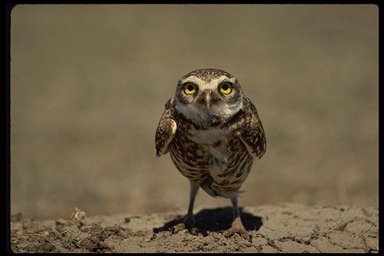
PRONGHORNS AND PRAIRIE DOGS
This natural region is often referred to in the past tense, in terms of what once
was. It was once an ocean of grass, broken by wide wooded valleys and
forest-clad hills. It was once Canada's richest wildlife region, reminiscent of the
savannah country of East Africa. But we will never really know what it was like.
Only the wind remains unchanged, blowing unceasingly across the sweeping
plains.

THE LAND:
A vast tilted plain, the land rises gently until it ends abruptly at the foothills of the Rockies. The monotonous flatness is interrupted by weirdly eroded badlands, sand dunes, coulees, rocky canyons, potholes, hills and sweeping river valleys. This region rests on a thick mantle of rich, black soil that is cool and moist to the touch - some of the most fertile soils in the country. Within the fertile grasslands is "Palliser's Triangle", semiarid country considered unsuitable for agriculture or stock raising in the opinion of John Palliser, leader of a scientific expedition along the American boundary in 1857-1860.

VEGETATION:
Speargrass, wheatgrass, blue grama, rough fescue, bluebunch fescue, red fescue, needlegrass, little blue-stem -- grass is the single characteristic common to the mosaic of habitats making up this region. Mixed prairie, dominated by speargrasses and wheatgrasses, is the most extensive grassland type in this region. Mixed Prairie, as its name implies, includes both tall and short grasses. Blue grama, a drought-resistent short grass, is important in dry sites.
River valleys and old drainage channels, important routes for the invasion of plant species that survived the last glaciation beyond the edge of the ice sheet, harbour a rich variety of trees and shrubs: oaks, American elm, cottonwood, Manitoba maple, and green ash, among others. Shallow depressions, some of which are periodically flooded, harbour communities of salt-resistent species, such as alkali grass and wild barley. The thousands of sloughs that characterize this region, ranging in area from a few square metres to several hectares, are dominated by tall sedges and grasses.
WILDLIFE:
It is difficult to imagine the richness of the wildlife of this natural region in pre-settlement days. Herds of bison so vast that they took days to pass, along with untold numbers of pronghorn antelope, mule deer, white-tailed deer and elk, roamed this wilderness of grass stalked by the prairie grizzly, prairie wolf, cougar and other predators.

Today only remnants of this rich fauna remain in the most remote and driest corners of the region. Here, species endemic to the prairies, such as the pronghorn antelope, black-tailed prairie dog and plains pocket gopher, can still be found. The black-footed ferret and greater prairie chicken once lived here, but are believed to have been extirpated.
Waterfowl nest in the potholes that dimple this region, earning it the title "The Duck Factory of North America". The open grasslands still provide habitat for such unique prairie species as the sage grouse and sharp-tailed grouse, along with introduced species such as the ring-necked pheasant and the Hungarian partridge.
Several interesting species of reptiles and amphibians are restricted in Canada to this region: the prairie rattlesnake, the eastern short-horned lizard, the plains spadefoot toad, and the great plains toad, among others.
THE STATUS OF NATIONAL PARKS:
This region is represented by Grasslands National Park. In the dry hills, badlands and eroded river valleys, a diversity of wildlife, including pronghorns, rattlesnakes and the only remaining black-tailed prairie dog colonies in Canada, can still be found in this wild corner of the prairies. Archeological investigations conducted to date reveal that the park is one of the richest areas of Northern Plains Indian culture in North America.
A 1981 agreement between the Governments of Canada and Saskatchewan, revised in 1988, provides for the establishment of the park encompassing 906 square kilometres. The park will be proclaimed under the National Parks Act once sufficient lands have been acquired. Approximately 50% (450 km2) of lands required for the park have already been acquired on a "willing-seller willing-buyer" basis.